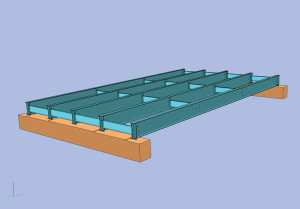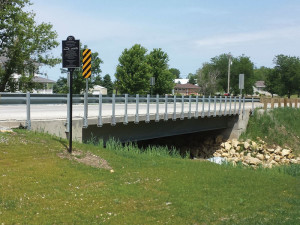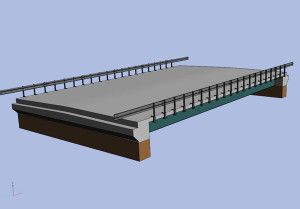eSPAN140 Facilitates Speedy Concept-to-Completion
In late 2013, Iowa’s Buchanan County engineers teamed with academia and industry to launch the V65 Jesup South Bridge Demonstration Project with the goal of illustrating the advantages of the eSPAN140 short span steel bridge design tool to accelerate steel bridge design and construction.
At the heart of the design tool, developed by the Short Span Steel Bridge Alliance’s (SSSBA), the steel industry and Steel Market Development Institute (SMDI), is the use of standard steel beams and other elements that are readily available from the steel industry. The success of the tool strongly depends on the ability of steel fabricators to turn around the conceptual designs produced by the tool with minimal work.
U.S. Bridge teamed with other industry partners to complete the demonstration project and assess the value of the tool to speed the delivery of bridge elements to the jobsite.
Bridge Basics
The old Jesup South Bridge is located on one of the busiest roads in Buchanan County. Originally built in 1947, the deteriorating structure had a sufficiency rating of 49, making it a prime candidate for replacement. The bridge was narrow and not built for the loads required to support today’s traffic. County engineers sought to replace the existing 22-foot-wide bridge with a modern 40-foot-wide bridge using galvanized steel rolled beams and galvanized rebar.
Around the same time, Buchanan County’s County Engineer Brian P. Keierleber, P.E., heard about the development of the eSPAN140 tool and the interest by the researchers at West Virginia University, the University of Wyoming and the SSSBA in documenting the benefits of the tool.
Keierleber volunteered the Jesup South Bridge as a candidate for the SSSBA’s proposed demonstration project because the demonstration project presented a unique opportunity to see how the eSPAN140 tool could streamline the steel bridge design and construction process and open the door to alternative bridge replacement options.
While the project was mostly driven by Buchanan County, SSSBA sought volunteers from the bridge design and construction community to facilitate the project (see Jesup South Bridge Demonstration Project Team below). As an SSSBA member, U.S. Bridge knew about the development of the eSPAN140 tool. The demonstration project provided a perfect opportunity to translate the eSPAN140 data to design and fabrication in a practical setting.
All the project participants visited the site to gain a full picture of the project and discuss expectations. For U.S. Bridge, the biggest concern at the time was to clarify responsibilities for the volunteer team, since the process would be a little different than a conventional project delivery.

U.S. Bridge modeled, detailed and fabricated the short span steel bridge elements based on initial design details from eSPAN140.
Concept to Construction
In September 2013, Keierleber logged into the eSPAN140 site to design the new Jesup County Bridge. He input bridge length, width and number of lanes. He wanted a bridge with a 63-foot span and two striped traffic lanes, supported by five standard girders. The eSPAN140 tool is coded to use the AASHTO LRFD bridge code and corresponding HL-93 Vehicular Loading design codes. Within minutes, he received a customized steel bridge design as a PDF file that echoed his inputs and organized the information in a commonly depicted format (a format normally found in a set of contract documents). The eSPAN140 plans indicated composite beam sections from a W40x149 (the deepest/lightest beam) to a W24x192 (the shallowest/heaviest beam) for a bay spacing of 10 feet 6 inches.
These results, called a “Steel Bridge Solutions” file from eSPAN140, also included typical bridge cross-sections and roadway widths, travel lanes and shoulders, and more, as well as the design and fabrication details for standardized rolled beams with slab thickness, girder spacing, bearing elevations and stiffener positions shown. It’s worth noting here that eSPAN140 does leave off at a certain point. For instance, if the bridge engineer doesn’t select the shallowest depth or lightest weight options that eSPAN140 offers for the optimal spacing, the engineer or fabricator will need to complete a final analysis and some design tasks to calculate accurate deflection values (for camber) and any updates to the shear stud spacing.
Buchanan County’s County Engineer especially liked the user-friendly appeal of the eSPAN140 tool, which facilitated price comparisons of different bridge concepts to find the most economical solution.
With plans in hand for the new Jesup South Bridge, Keierleber prepared contract drawings and coordinated the design with U.S. Bridge, who would model, detail and fabricate the short span steel bridge elements.
The County’s design plans reiterated the use of composite beam/deck construction, jointless integral abutment details and steel channel members as diaphragms – all consistent with Iowa DOT standards and the details given by eSPAN140. For the bridge railing, the County proposed a new crash tested steel post and w-beam rail called the MGS Bridge Rail System.
The County’s selected framing layout consisted of five lines of W36x135 spaced at 8 feet 8½ inches and a slab overhang of 2 feet 7 inches. The diaphragm channels were MC18x 42.7 and were located at each bearing and at approximately one-third points along the span.
Once the designer’s criteria was fully specified, eSPAN140 provided the level of detail that U.S. Bridge needed to move immediately to the next stage – and it was pretty easy to do. The steel bridge solution details outlined in the eSPAN140 results file provided enough information to drive the finer detailing requirements and fabrication processes. In addition to the erection plans and shop drawings, the U.S. Bridge team added some construction plans including a stay-in-place (SIP) formwork layout and railing installation plan, and supplemented the construction documents with some Iowa Department of Transportation standards because they were referenced by the county engineer.
High-Gear Fabrication
Plans for erecting the steel framing and installing the railing were submitted in concert with the steel shop drawings. These plans were reviewed by Buchanan County and, once approved, allowed the fabricator to move into high gear, releasing the shop drawings for fabrication and bringing the steel into the fab shops.
The beams were drilled via a CNC controlled drill line, saw cut to exact length and cambered for dead load in preparation for stiffener fit up and welding. Bearing stiffeners ¾-inch thick and intermediate connection stiffeners ½-inch thick were plasma cut and drilled, again via CNC equipment, and then welded with 5/16-inch fillet welds to the beams with a tight fit to the top and bottom flanges. Welding was performed using a semi-automatic procedure with E71T-1 flux core (FCAW) wire.
About one month after receiving the plans from eSPAN140, U.S. Bridge was able to begin shipping elements to the galvanizer for conditioning. After an internal quality control inspection, the beams were hot-dip galvanized according to ASTM 123 and checked again for coating thickness and any camber loss.
The beams were delivered to the bridge construction site and set on October 2, 2013 where it was constructed by local crews. The Jesup South Bridge opened to traffic on November 19, 2013 – just three months after Buchanan County first entered the details into eSPAN140.
Lessons Learned
From a time perspective, eSPAN140 is a handy tool that bridge engineers can utilize to get quick answers and evaluate alternatives directly, zeroing in on feasible options from a wide range of steel superstructure types.
From a fabricator’s perspective, eSPAN140 is a helpful program that facilitates good dialogue with a client early on about steel sections, depths of structure, lifting weights, standard details, fabricating processes, corrosions protection, etc. – all the things that make steel a great bridge building material. The detailed design provides a good foundation for a fabricator to know, more or less, how a steel bridge option is going to solve a problem and what the owner can expect in terms of fabricated and installed costs. If it’s a ‘GO’, then U.S. Bridge is quickly on the way to producing bridge members for construction.
The Jesup Bridge project is yet another example of the innovativeness of local infrastructure managers across the country. Undaunted by challenges of cost or material, they continue to seek out ways to plan, design and build modern and safe improvements, making the most of limited resources and their own workforce.
The goal of the eSPAN140, according to SMDI, is to provide bridge engineers with another tool in their toolbox to develop cost-effective solutions for their bridge repair and replacement challenges.
While the materials for the Jesup South Bridge were donated, case studies for similar short span bridges have documented a 25% cost advantage when compared to concrete alternatives. Please see www.shortspansteelbridges.org for more information.
View a time-lapsed video of the Jesup South Bridge construction process on the Short Span Steel Bridge Alliance website.▪
About the Short Span Steel Bridge Alliance
The Short Span Steel Bridge Alliance (SSSBA) is a group of leaders in the bridge and buried soil steel structure industry who have joined together to provide educational information and design tools for the cost-effective design and construction of short span steel bridges in installations up to 140 feet in length. For more information, visit www.shortspansteelbridges.org.
Jesup South Bridge Demonstration Project Team
Donating Companies
- U.S. Bridge: Bridge Superstructure Fabrication, Railing Materials and Fabrication, Steel Detailing
- Nucor-Yamato Steel: Rolled Beams/Girders
- Skyline Steel: H-Piles for the Integral Abutment System
- AZZ Galvanizing: Galvanizing
- Nucor Fastener/Ziegler Bolt & Part Co.: Superstructure and Rail Fasteners
- St. Louis Screw and Bolt: Shear Studs
- BlueArc Stud Welding: Stud Welding
- D-Mac Industries: Stay-in-Place Forms
- Gerdau: Memphis Reinforcing Steel: Rebar
- Buchanan County, Iowa: Installation/Demolition
University Partners
- West Virginia University: eSPAN140 Development, Design Coordination and Research
- University of Wyoming: eSPAN140 Development, Design Coordination and Research
- Iowa State University: Research


